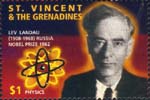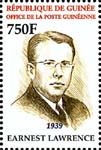L


1955 Nobel Physics prize for his discoveries concerning the fine structure of the hydrogen spectrum. Lamb Jr. was born on July 12, 19I3 in Los Angeles, California. His father Willis Eugene Lamb, born in Minnesota, was by profession a telephone engineer and his mother Marie Helen Metcalf came from Nebraska. Except for three years schooling in Oakland, Calif., he was educated in the public schools of Los Angeles, Calif. In 1930 he entered the University of California at Berkeley and received a B.S. (Chemistry) in 1934. His graduate work in theoretical physics at the same university led to the Ph.D. degree in 1938. His thesis research on the electromagnetic properties of nuclear systems was directed by Professor J. R. Oppenheimer. He went to Columbia University as Instructor in Physics in 1938, became an Associate (1943), Assistant Professor (1945), Associate Professor (1947) and Professor in 1948. From 1943 to 1951, he was associated also with the Columbia Radiation Laboratory where the research described in the Nobel Lecture was done. In 1951 he went to Stanford University in California as Professor of Physics. During 1953-1954 he was Morris Loeb Lecturer at Harvard University. From 1956 to 1962 he was a Fellow of New College and Wykeham Professor of Physics at the University of Oxford, England. In 1962 he became Henry Ford II Professor of Physics at Yale University, New Haven, Conn. His research has been on the following subjects: theory of the interactions of neutrons and matter, field theories of nuclear structure, theories of beta decay, range of fission fragments, fluctuations in cosmic ray showers, pair production, order-disorder problems, ejection of electrons by metastable atoms, quadrupole interactions in molecules, diamagnetic corrections for nuclear resonance experiments; theory and design of magneton oscillators, theory of a microwave spectroscope, study of the fine structure of hydrogen, deuterium and helium; theory of electrodynamic energy level displacements. In 1953 he received the Rumford Premium of the American Academy of Arts and Sciences. The University of Pennsylvania conferred an honorary degree of D.Sc. upon him in 1954. He received the Research Corporation Award in 1955. He is a member of the National Academy of Sciences, and a Fellow of the American Physical Society.
Born: 22 Jan 1908 in Baku, Azerbaijan, Russian Empire
Died: 1 April 1968 in Moscow, USSR

Info
1962 Nobel Physics prize for his pioneering theories for condensed matter, especially liquid helium


Laplace understood the universe to be totally operative under the impersonal laws of nature. So in 1773 he set out to give full mathematical explanation to the motions of the heavens--in such a way that there would be no more need to call in "God" as the residual part of the equation. This he successfully did through an unprecedentedly in-depth mathematical calculation of the eccentricities in the planetary orbits--taking into account their gravitation attraction to each other as well as to the sun as they moved through their respective orbits. (This work was eventually compiled into the five-volume study: Traité de mécanique céleste/Celestial Mechanics.)
Laplace's work earned him a place in the prestigious French Academy of Sciences. It also removed the idea of God further (if not completely) from the mechanistic cosmology that had been unfolding over the previous century. Not even deism could stand up to this assault. Indeed, the story goes that when Laplace presented a copy of his work to Napoleon, the latter uttered a concern that Laplace had made no mention in his work of the Divine "Originator" of this marvelous system--to which Laplace replied: "I had no need for that hypothesis!"
From his understanding of the dynamics of the attractions of any particle circling around a central, attracting point, Laplace speculated that the solar system had come into being through a similar gravitational force. He theorized in Exposition du système du monde/The System of the World (1796) that the cosmos had begun as nebular gas, and the gravitational concentrating of matter had over the aeons gradually produced a concentrating of this gas into a number of mass bodies which today make up the solar system.
Over the years of his study he had worked carefully in developing the "probabilities" of the occurrence of events over time. His work in this area he published in 1814 as Essai philosophique sur les probabilités/A Philosophical Essay on Probability. In this study he lifted mathematics from an absolutist accounting of events to a more accurate "probabalistic" accounting of those events. Thus Laplace became a major contributor to the growing field of statistics.
1998 Nobel Physics prize for their discovery of a new form of quantum fluid with fractionally charged excitations

Info

1939 Nobel Physics prize for the invention and development of the cyclotron and for results obtained with it, especially with regard to artificial radioactive elements

1988 Nobel Physics prize for the neutrino beam method and the demonstration of the doublet structure of the leptons through the discovery of the muon neutrino

Info
1957 Nobel Physics prize for penetrating investigation of the so-called parity laws which has led to important discoveries regarding the elementary particles
Born: 1 July 1646 in Leipzig, Saxony (now Germany)
Died: 14 Nov 1716 in Hannover, Hanover (now Germany)

Biography

Lemaitre, a Belgian cosmologist, astrophysicist and priest, was interested in the problem of the creation of the universe and proposed a theory of an expanding universe based on his solutions to Einsteins equations of general relativity. He envisioned a primal atom containing all the matter in the universe, which exploded at some point 10-20 billion years ago, hurtling elementary particles and photons outward, where they cooled and condensed eventually to form the light elements, heavy elements, molecules, and finally galaxies. The Big Bang theory, as it was derisively called by Fred Hoyle, a proponent of a steady state theory of the universe, is supported by many independent astronomical observations, starting with Hubble's observations of receding galaxies and the discoveries of Penzias, Wilson, and Fowler, above. A note found in Lemaitre's manuscripts said "It all had to have begun with light.

1905 Nobel Physics prize for his work on cathode rays. He was the first scientist born in Hungary to win the Nobel Prize. His scientific career started under Eötvös in Budapest, but he later moved to Germany where he died. He started his research activity under the leadership of Heinrich Hertz (1857 - 1894) relating to the radiation generated in the Crookes tube. He passed the cathode rays through a thin metal sheet (Lenard window) out of the tube to the atmosphere or into another closed tube, thus allowing them to be studied. He found that the permeation capability of rays depends on their speed. During their permeation through materials, the rays are exposed to forces. He came to the conclusion that the atoms are composed of positive and negative particles that fill only a very small part of the space (dynamide theory). The cathode ray carries negative charge in some way.
In studying the photoelectric effect, he found that the speed of electrons leaving a metal surface depends only on the frequency while the number of electrons depends on the intensity of light. His former discovery founded the basis for the atom theory of Ernest Rutherford (1871 - 1937) while the second served as a basis for discovering the law of the photoelectric effect developed by Albert Einstein (1879 - 1955). His important results were the discovery of limit wavelength in the photoelectric effect and the role of activators in phosphorescence.
Born: 11 March 1811 in Saint-Lo, France
Died: 23 Sept 1877 in Paris, France

His main work was in celestial mechanics. Working independently of Adams, Le Verrier calculated the position of Neptune from irregularities in Uranus's orbit. As one of his colleagues said:- ... he discovered a star with the tip of his pen, without any instruments other than the strength of his calculations alone.
Biography

Info